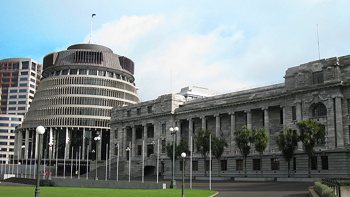A groundbreaking genetic engineering project, backed by movie director Sir Peter Jackson and iwi Ngāi Tahu, is aiming to bring the extinct South Island giant moa back from the dead.
Work on the dramatic Jurassic Park-style de-extinction scheme is under way, the Herald has learned.
Archaeologists have already visited caves known to contain significant moa subfossil deposits, which could be used to sequence and rebuild genomes for the toweringly tall lost birds, extinct for six centuries.
The project is backed by United States-based Colossal Biosciences, which has already revived a modern version of the dire wolf - extinct for 10,000 years - and has designs on the woolly mammoth and dodo.
The Texan billionaire behind the company is bullish on a timeline for the moa’s return.
“I’m confident this will be under a decade,” Colossal chief executive Ben Lamm told the Herald in an exclusive interview, nearly 30 years after Dolly the sheep became the first mammal cloned from an adult cell.
“I’m bullish, so I will say we’re going to try to get it done in five years. Peter Jackson [...] gives me lots of feedback, quite often, as an investor, supporter, and initiator of the project, that we need to get it sooner.
“But I think it’s a five to eight-year project, and as an eternal optimist, I think it will be on the earlier stages of that. This isn’t a 30-year project.”
 Sir Peter Jackson and Colossal Biosciences chief executive Ben Lamm with moa bones.
Sir Peter Jackson and Colossal Biosciences chief executive Ben Lamm with moa bones.
Jackson, the star director behind The Lord of the Rings trilogy, The Beatles: Get Back, and They Shall Not Grow Old, was an early investor in Colossal Biosciences, having reportedly poured in more than $10 million.
Other celebrity investors include socialite Paris Hilton, champion NFL quarterback Tom Brady and actor Chris Hemsworth.
But it was Jackson who pushed Lamm to include the moa on the de-extinction hit-list.
Jackson told the Herald he was “delighted” to partner Ngāi Tahu and Colossal on “a mission to save some of our most precious taonga”.
“Resources will be put into ensuring some of the most critically endangered species in Aotearoa/New Zealand are protected for future generations,” the 63-year-old said.
“With the recent resurrection of the dire wolf, Colossal has also made real the possibility of bringing back lost species.
“There’s a lot of science still to be done – but we can start looking forward to the day when birds like the moa or the huia are rescued from the darkness of extinction.”
 Moa (dinornis robustus) stood up to 3.6m tall with neck outstretched and weighed about 230kgs.
Moa (dinornis robustus) stood up to 3.6m tall with neck outstretched and weighed about 230kgs.
Experts from the Christchurch-based Ngāi Tahu Research Centre, set up in 2011 to support the intellectual growth and development of the principal iwi of the South Island, will direct “all aspects of the project”.
Kyle Davis, Ngāi Tahu archaeologist, admits that the bold scheme might provoke wide-ranging opinions, with some people potentially questioning whether they are “playing God”.
But he does not think it will divide an iwi committed to “new knowledge” and cutting-edge research, which he says is especially important three decades beyond Treaty of Waitangi settlement.
“For seven or eight generations prior, they were living with the wash-up of colonial dispossession, in a place of nightmares, and we’ve shifted to an actual place of dreams,” Davis said.
“We get to dream our dreams and as part of that, we get to, as our ancestors did between 1800 and the 1830s, engage with the wider world and once again be an active global people.
“These are the things that can happen when a tribe is recapitalised. This is a thing that helps and nourishes a new sense of ourselves, but in a way that looks back into our heritage.”
 Ngāi Tahu archaeologist Kyle Davis.
Ngāi Tahu archaeologist Kyle Davis.
The flightless moa (dinornis robustus) were endemic to New Zealand and consisted of nine distinct species, ranging from turkey-sized species to the South Island giant moa, which stood up to 3.6m tall with its neck outstretched and weighed about 230kg.
Recent research has found that moa populations were stable until human arrival, and extinction happened within 100-150 years of Polynesian settlement, primarily due to hunting and habitat change.
Its rapid extinction represents one of the most well-documented examples of human impact on megafauna.
Ngāi Tahu Research Centre director, Professor Mike Stevens said moa harvesting was a factor in transforming tropical East Polynesian explorers into subtropical South Polynesian Māori.
“During the 14th and 15th centuries, moa provided meat for sustenance, and bones and feathers for tools and decoration, especially in Te Waipounamu.
“And the loss of moa, through over-harvesting and habitat modification, was a salutary lesson as to the New Zealand archipelago’s ‘fragile plenty’.”
Collaborating scientist Paul Scofield, senior curator of natural history at Canterbury Museum, welcomed the de-extinction initiative, along with the plans, funding, and resources to create a regional biobank for taonga species beyond the moa.
Canterbury Museum holds the largest collection of moa remains in the world.
 Ben Lamm and Sir Peter Jackson are bullish on timelines for the ambitious moa project.
Ben Lamm and Sir Peter Jackson are bullish on timelines for the ambitious moa project.
Many of the Christchurch museum’s moa bones, which are up to 10,000 years old, are well-preserved after being retrieved from South Island swamps and caves.
Many contain “quite a lot of DNA”, Scofield said.
Over the past few months, Colossal scientists have been painstakingly analysing moa material in laboratories.
They have also been assessing the DNA of what they believe is a closely related - and still living - South American bird species.
The latter could potentially be used as donor animals and a starting point for genetically engineering traits of the lost moa into them.
 Moa birds were endemic to New Zealand but died out about 600 years ago.
Moa birds were endemic to New Zealand but died out about 600 years ago.
The biotech firm has already established a “complete genome” of one of those species, something that Schofield called “an astonishing achievement”.
And it’s hoped that over the next “couple of years” they will be producing genomes of each of the nine species of moa, starting with the South Island giant moa.
Lamm, who founded Colossal with world-renowned geneticist George Church, confirmed his team are in the process of “ancient DNA extraction and ancient DNA assembly” on numerous species of moa, while also working on getting the comparative genomics of the closest living species.
“We’re not there, but we’re off to the races,” he said.
Colossal’s work so far, however, has created controversy.
Some scientists have argued that revived breeds, such as the dire wolf, are just modern animals with DNA from extinct animals added, rather than a genuinely resurrected extinct species.
University of Otago department of zoology associate Professor Nic Rawlence told The Front Page he challenges the term “de-extinction”.
“The technology they’ve developed is stunning and will have very real-world conservation benefits, but it’s not de-extinction. This is a genetically modified, designer grey wolf,” Rawlence said.
Dr Beth Shapiro, Colossal’s chief science officer, however, has argued in the past that its mammoths and dire wolves have key traits that make their lineage of organisms distinct.
The company says that, in the case of the dire wolf, they have recreated the actual phenotype of that animal.
Part of the research involves detailed studies and 3D printed models of what the impact of bringing moa back into the wild might be.
When the time comes, the partnership aims to house the first resurrected moa in “expansive, secure ecological reserves”.
The plan invites comparisons to the hit 1993 Hollywood movie, Jurassic Park, starring Kiwi star actor Sam Neill, where cloned dinosaurs roamed amok on an island theme park off the coast of Costa Rica - a prospect downplayed by Colossus.
“You’re not going to have them running around Christchurch,” Lamm said.
“And then, over time, based on what the Māori, the Government, and other people want, that’s really up to New Zealand to decide.”
Kurt Bayer is NZ Herald South Island Head of News based in Christchurch. He is a senior journalist who joined the Herald in 2011.
Take your Radio, Podcasts and Music with you









